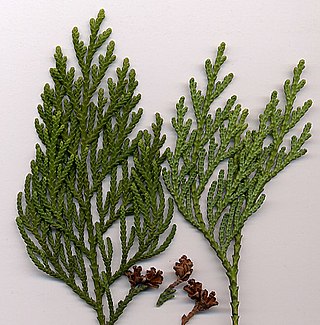
Thuja is a genus of coniferous tree or shrub in the Cupressaceae. There are five species in the genus, two native to North America and three native to eastern Asia. The genus is monophyletic and sister to Thujopsis. Members are commonly known as arborvitaes, thujas or cedars.
Cypress is a common name for various coniferous trees or shrubs of northern temperate regions that belong to the family Cupressaceae. The word cypress is derived from Old French cipres, which was imported from Latin cypressus, the latinisation of the Greek κυπάρισσος (kyparissos). Cypress trees are a large classification of conifers, encompassing the trees and shrubs from the cypress family (Cupressaceae) and many others with the word cypress in their common name. Many cypress trees have needle-like, evergreen foliage and acorn-like seed cones.
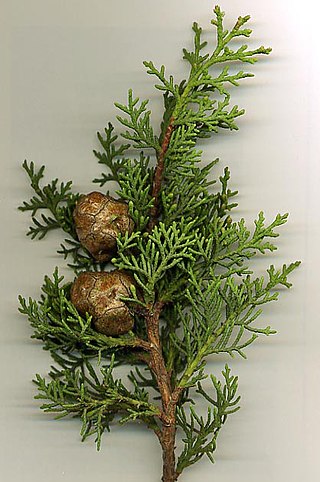
Cupressaceae is a conifer family, the cypress, with worldwide distribution. The family includes 27–30 genera, which include the junipers and redwoods, with about 130–140 species in total. They are monoecious, subdioecious or (rarely) dioecious trees and shrubs up to 116 m (381 ft) tall. The bark of mature trees is commonly orange- to red-brown and of stringy texture, often flaking or peeling in vertical strips, but smooth, scaly or hard and square-cracked in some species.
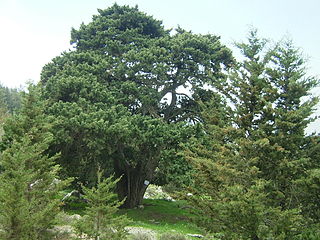
Cupressus is one of several genera of evergreen conifers within the family Cupressaceae that have the common name cypress; for the others, see cypress. It is considered a polyphyletic group. Based on genetic and morphological analysis, the genus Cupressus is found in the subfamily Cupressoideae. The common name "cypress" comes via the Old French cipres from the Latin cyparissus, which is the latinisation of the Greek κυπάρισσος (kypárissos).

The Mulanje Massif, also known as Mount Mulanje, is a large inselberg in southern Malawi. Sapitwa Peak, the highest point on the massif at 3,002 m, is the highest point in Malawi. It lies 65 km east of Blantyre, rising sharply from the surrounding plains of Phalombe and the Mulanje district.

Cupressus arizonica, the Arizona cypress, is a North American species of tree in the cypress family Cupressaceae, native to the southwestern United States and Mexico. Populations may be scattered rather than in large, dense stands.
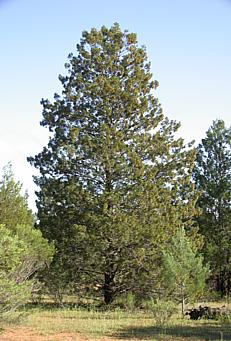
Callitris is a genus of coniferous trees in the Cupressaceae. There are 16 recognized species in the genus, of which 13 are native to Australia and the other three native to New Caledonia. Traditionally, the most widely used common name is cypress-pine, a name shared by some species of the closely related genus Actinostrobus.
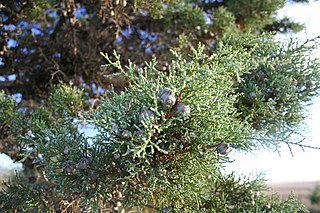
Actinostrobus is a genus of coniferous trees in the Cupressaceae. Common names include cypress, sandplain-cypress and cypress-pine, the last of these shared by the closely related genus Callitris.

Taxodium distichum is a deciduous conifer in the family Cupressaceae. It is native to the southeastern United States. Hardy and tough, this tree adapts to a wide range of soil types, whether wet, salty, dry, or swampy. It is noted for the russet-red fall color of its lacy needles.

Cupressus bakeri, reclassified as Hesperocyparis bakeri, with the common names Baker cypress, Modoc cypress, or Siskiyou cypress, is a rare species of cypress tree endemic to a small area across far northern California and extreme southwestern Oregon, in the western United States.

Tetraclinis is a genus of evergreen coniferous trees in the cypress family Cupressaceae, containing only one species, Tetraclinis articulata, also known as Thuja articulata, sandarac, sandarac tree or Barbary thuja, endemic to the western Mediterranean region.
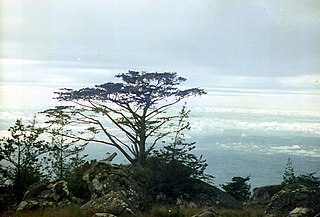
Widdringtonia is a genus of coniferous trees in the Cupressaceae. The name was Austrian botanist Stephan Endlicher's way of honouring an early expert on the coniferous forests of Spain, Capt. Samuel Edward Widdrington (1787–1856). There are four species, all native to southern Africa, where they are known as cedars or African cypresses.

Austrocedrus is a genus of conifer belonging to the cypress family (Cupressaceae). It has only one species, Austrocedrus chilensis, native to the Valdivian temperate rain forests and the adjacent drier steppe-forests of central-southern Chile and western Argentina from 33°S to 44°S latitude. It is known in its native area as ciprés de la cordillera or cordilleran cypress, and elsewhere by the scientific name as Austrocedrus, or sometimes as Chilean incense-cedar or Chilean cedar. The generic name means "southern cedar".

Cupressus lusitanica, the Mexican cedar or cedar-of-Goa, is a species of cypress native to Mexico and Central America. It has also been introduced to Belize, Costa Rica and Nicaragua, growing at 1,200–3,000 metres (3,900–9,800 ft) altitude.
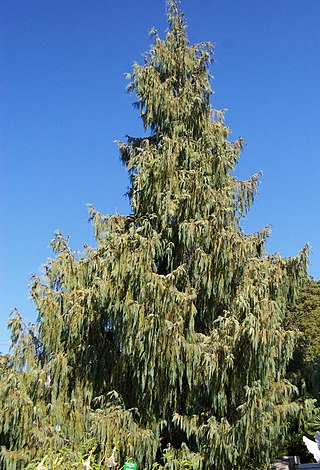
Cupressus cashmeriana, the Bhutan cypress or Kashmir cypress, is a species of evergreen conifer native to the eastern Himalaya in Bhutan and adjacent areas of Arunachal Pradesh in northeastern India. [ Now in vulnerable category, IUCN list retrieved in 2006 ]. It is also introduced in China and Nepal. It grows at moderately high altitudes of 1,250–2,800 metres (4,100–9,190 ft).

Juniperus tibetica, the Tibetan juniper, is a species of juniper, native to western China in southern Gansu, southeastern Qinghai, Sichuan, and Tibet Autonomous Region, where it grows at high to very high altitudes of 2,600–4,900 metres. This species has the highest known elevation treeline in the northern hemisphere.

Widdringtonia wallichii, Clanwilliam cedar or Clanwilliam cypress, previously Widdringtonia cedarbergensis is a species of Widdringtonia native to South Africa, where it is endemic to the Cederberg Mountains northeast of Cape Town in Western Cape Province. It is threatened by habitat loss and protected in South Africa under the National Forest Act of 1998.
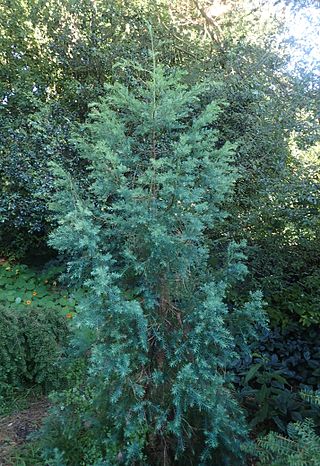
Widdringtonia schwarzii is a species of Widdringtonia native to South Africa, where it is endemic to the Baviaanskloof and Kouga Mountains west of Port Elizabeth in Eastern Cape Province; it occurs on dry rocky slopes and crags at 600–1,200 m altitude. It is threatened by habitat loss, particularly by wildfire. The Willowmore cypress is a protected tree in South Africa.

Widdringtonia whytei, the Mulanje cedar or Mulanje cypress, is a species of conifer native to Malawi, where it is endemic to the Mulanje Massif at altitudes of 1,830–2,550 m. It has become endangered as a result of over-harvesting for its wood, and an increase in the frequency of wildfires due to human activity.

Cupressus nevadensis, now reclassified as Hesperocyparis nevadensis, with the common name Paiute cypress, is a species of cypress tree native to a small area in Sierra Nevada of California, in the western United States.





















